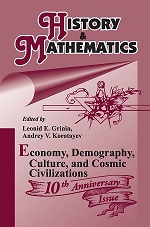
|
History & Mathematics:Economy, Demography, Culture, and Cosmic CivilizationsBibliography: Volgograd: ‘Uchitel’ Publishing House, 2017. – 240 pp.
Edited by: Leonid E. Grinin, and Andrey V. Korotayev
ISBN 978-5-7057-5247-8 Editorial Council: Herbert Barry III (Pittsburgh University), Leonid Borodkin (Moscow State University; Cliometric Society), Robert Carneiro (American Museum of Natural History), Christopher Chase-Dunn (University of California, Riverside), Dmitry Chernavsky (Russian Academy of Sciences), Tessaleno Devezas (University of Beira Interior), Leonid Grinin (National Research University Higher School of Economics), Antony Harper (Eurasian Center for Big History & System Forecast-ing), Peter Herrmann (University College of Cork, Ireland), Andrey Korotayev (Higher School of Economics), Alexander Logunov (Russian State University for the Humanities), Georgy Malinetsky (Russian Academy of Sciences), Sergey Malkov (Russian Academy of Sciences), Charles Spencer (American Museum of Natural History), Rein Taagapera (University of California, Irvine), Arno Tausch (Innsbruck University), William Thompson (University of Indiana), Peter Turchin (University of Connecticut), Douglas White (University of California, Irvine), Yasuhide Yamanouchi (University of Tokyo).
|
The present Yearbook (which is the sixth in the series) is subtitled Economy, Demography, Culture, and Cosmic Civilizations. To some extent it reveals the extraordinary potential of scientific research. The common feature of all our Yearbooks, including the present volume, is the usage of formal methods and social studies methods in their synthesis to analyze different phenomena. In other words, if to borrow Alexander Pushkin's words, ‘to verify the algebra with harmony’. One should note that publishing in a single collection the articles that apply mathematical methods to the study of various epochs and scales – from deep historical reconstruction to the pressing problems of the modern world – reflects our approach to the selection of contributions for the Yearbook. History and Mathematics, Social Studies and formal methods, as previously noted, can bring nontrivial results in the studies of different spheres and epochs.
This issue consists of three main sections: (I) Historical and Technological Dimensions includes two papers (the first is about the connection between genes, myths and waves of the peopling of Americas; the second one is devoted to quantitative analysis of innovative activity and competition in technological sphere in the Middle Ages and Modern Period); (II) Economic and Cultural Dimensions (the contributions are mostly focused on modern period); (III) Modeling and Theories includes two papers with interesting models (the first one concerns modeling punctuated equilibria apparent in the macropattern of urbanization over time; in the second one the author attempts to estimate the number of Communicative Civilizations).
We hope that this issue will be interesting and useful both for historians and mathematicians, as well as for all those dealing with various social and natural sciences.